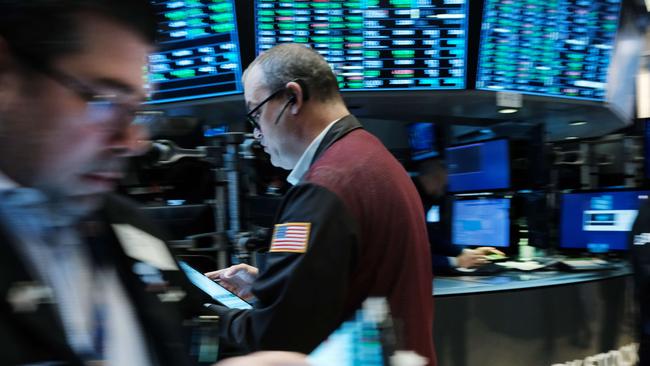Traders push through war, inflation and rate rises with shares up 8 per cent
Shares are climbing a wall of worry over inflation, interest rates, geopolitics and commodity prices with the ASX 200 booking strong growth since Russia invaded Ukraine.

Business
Don't miss out on the headlines from Business. Followed categories will be added to My News.
Shares are climbing a wall of worry over inflation, interest rates, geopolitics and commodity prices.
The MSCI World Index has risen 8 per cent in the past three weeks despite the highest US CPI in five decades, a 50-basis-point rise in the US 10-year bond yield to an almost three-year high, the first US rate rise since 2018 and calls for accelerated tightening, and extremely volatile and elevated oil prices.
The S&P 500 was up 6.8 per cent and Australia’s S&P/ASX 200 rose 5.8 per cent in the same period.
European sharemarkets have lagged because of their dependence on Russian gas, but most markets are now trading a few per cent higher than they were when the Ukraine war broke out and the West hit Russia with a barrage of economic sanctions that magnified the surge in energy prices.
While that is consistent with the historical tendency for shares to bottom out soon after the start of wars and other major geopolitical shocks, the recent rebound happened faster than most.
Looking at the impact of such events since WWII, AMP Capital chief economist Shane Oliver found that the S&P 500 fell by 6 per cent on average.
However, the US benchmark index was 6 per cent higher after three months, 9 per cent higher over six months and 15 per cent higher over 12 months.
After Russia announced its “special operation” in Ukraine, the S&P 500 fell as much as 2.6 per cent, but the sell-off did not even last a day. As of Wednesday it was 5.5 per cent higher than it was pre-war.
On a technical basis, the S&P 500 and ASX 200 now look quite positive. Both have regained their upward-sloping 200-day moving averages and have formed uptrends in peaks and troughs that negate the previous downtrends. For what it’s worth, they do remain in “correction” territory as they haven’t yet risen 10 per cent or more from the recent lows.
Local sharemarket volume has been light this week.
With the ASX 200 up 5.9 per cent in the past 12 days – nine of them up days – institutional investors may be waiting for greater reassurance the Ukraine war will not lead to a wider conflict.
But there has clearly been a lack of selling, in turn sucking the market higher.
That may be due to the usual deluge of dividend payments at this time of year. Bell Potter’s head of institutional sales and trading, Richard Coppleson, has worked out that a record $36.3bn in dividends will be paid to shareholders in March and April. Next week is a particularly big one for dividends, as $21.2bn will be paid.
The assumption is that much of the money paid out in dividends will flow back into the market in coming weeks since interest rates are still too low to attract deposits, while property has run hard and may suffer from rising interest rates.
Having told clients to buy the dip in US shares after their fourth-worst start to a calendar year since 1929, Canaccord’s US equity strategist Tony Dwyer is sticking to his positive view.
“Although we expect the tumultuous market behaviour to continue as investors grapple with the highest inflation in a generation and a ground war in Europe, our key intermediate-term tactical indicators and the history of such strong four-day rallies like last week suggest shifting our focus to the intermediate-term opportunity on further periods of weakness,” he said.
His call was for a weak January after last year’s 27 per cent rise in the S&P 500, a tumultuous first half with violent moves in both directions, and a year-end opportunity to rally back to unchanged as the economy continued to grow on the back of increased services spending and full reopening.
While not advocating chasing the current rally given the macroeconomic backdrop, he said the 14 per cent drop in the S&P 500 from its January 4 peak to last week’s low caused his key tactical indicators to reach an oversold or overly pessimistic condition.
Those indicators could get more oversold, but “already reflect a substantial amount of fear”.
In addition, the S&P500 had a four-day gain of 6.95 per cent for only the 17th time since 1957.
While the prior 16 occurrences had mixed near-term results, 14 of those 16 instances showed a double-digit gain a year later with a median rise of 23 per cent, and only one loss, when it fell 21.6 per cent in the 12 months after March 2000.
“This points to a very high probability that any further short-term losses should be more than offset as we move towards year-end,” Mr Dwyer said. “Our fundamental core thesis continues to point to positive economic growth driven by continued liquidity and economic transition to services as the economy fully reopens from the pandemic.”
He said bulls would be wrong if the economy fell into recession.
But while inflation, higher interest rates, the Russian invasion of Ukraine and the economic transition from goods to services spending could have a dampening effect on growth, his view was that growth had enough momentum from economic stimulus and reopening to stay positive.
“We continue to see a very tumultuous environment in the first half, but the significant decline in equities, intermediate-term oversold condition and history following such strong four-day rallies suggest using further bouts of weakness as an opportunity to add exposure rather than something to fear.”
Originally published as Traders push through war, inflation and rate rises with shares up 8 per cent



